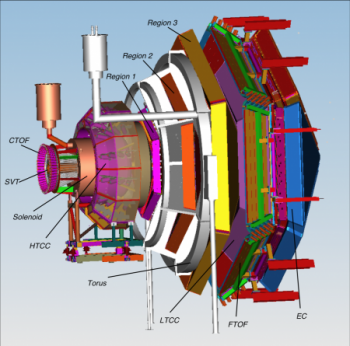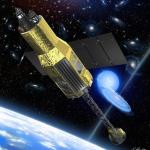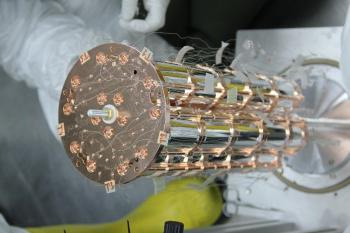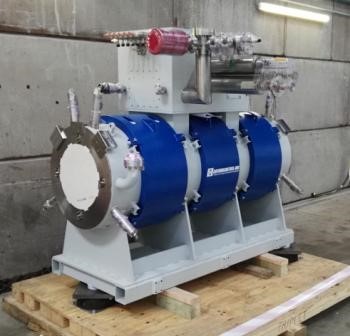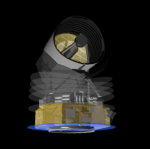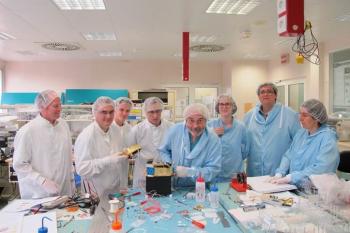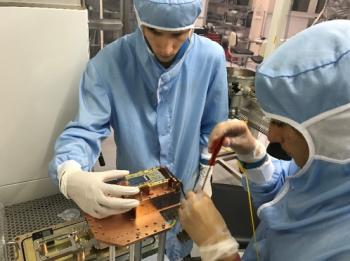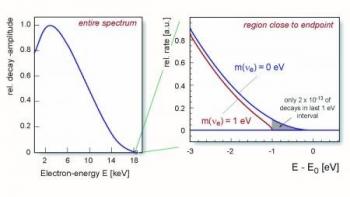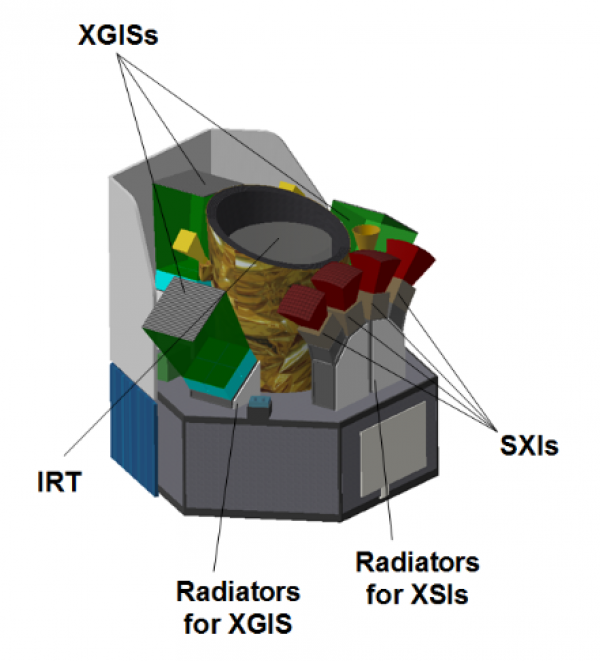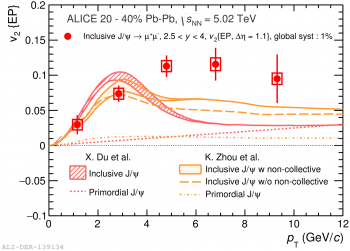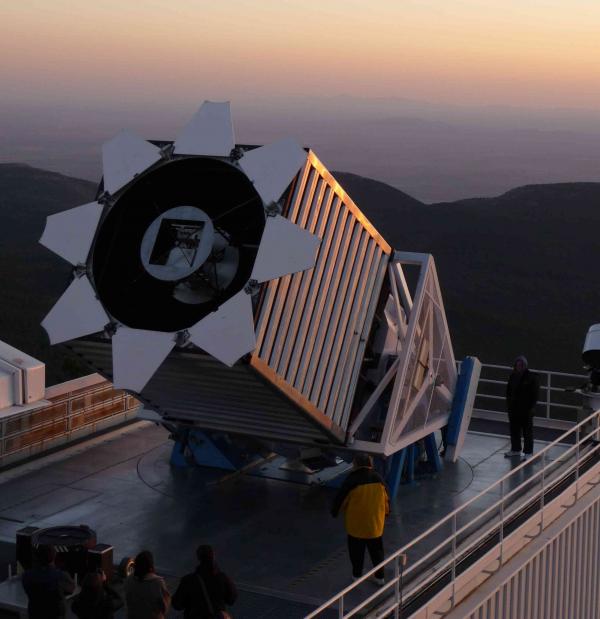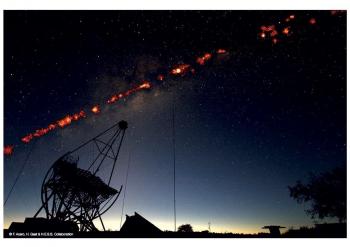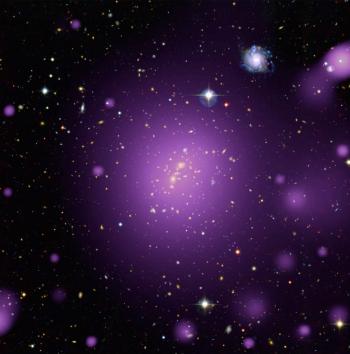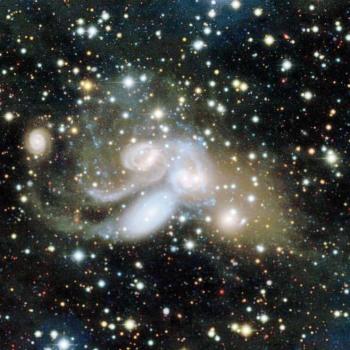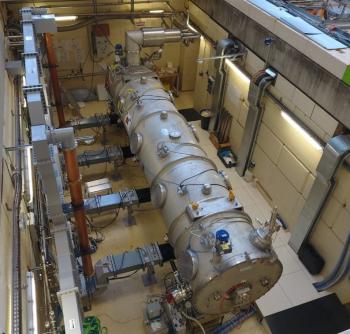As part of the new CLAS spectrometer project for the 12 GeV electron energy upgrade of the Jefferson Lab (USA) IRFU has been conducting R&D for more than 10 years to design and build a new generation tracker, using thin and flexible MICROMEGAS detectors that are now operating with the new CLAS12 spectrometer. After one year of installation, this tracker is operational and meets the expected characteristics with more than 95% detection efficiency and a spatial resolution of less than 100μm. After a dedicated data collection to measure the detector response, the new CLAS12 spectrometer is now collecting data for the DVCS physics experiment, where IRFU also participates and which objective is to measure the internal structure of the proton in three dimensions.
The exceptional success of the tracker project, that results from a close collaboration between IRFU's engineering and physics departments (DEDIP, DIS and DPHN), has been an example for other projects. Let us quote the LHC experiments for particle hunting, the muonic imaging of the pyramids, as well as a transfer of know-how to industry.
Despite a short period of activity, the japanese space agency (Jaxa) Hitomi satellite has shown its full potential by delivering relevant information’s on several celestial objects. In a series of works based on these observations and gathered in an issue of the review Publications of the Astronomical Society of Japan (PASJ), the Hitomi collaboration (among it researchers from the Astrophysical Department of CEA-Irfu Saclay) presents results that take advantage of the exceptional spectral resolution of the SXS spectrometer, one of the payload instrument. At the heart of this work is a detailed study of the dynamics of plasma in the center of an active galactic nucleus, of the ejecta of several supernova remnants, of the composition of matter in a binary system or the search for X and radio correlations in the Crab pulsar thanks to the high temporal resolution. Performed during the verification and calibration phase of the instruments before the satellite failed, these observations and the quality of the results confirm the community's choice on the instruments and the high potential of the high resolution X-rays spectroscopy. The Hitomi team is currently preparing its successor, Xrism (X-Ray Imaging and Spectroscopy Mission) and ESA is on its side working on the Athena project, a major X-rays observatory in which CEA is deeply involved
Read more in : Haute résolution pour le satellite Hitomi (in French)
In 2018, IRFU is participating in a publication CUPID-0: the first array of enriched scintillating bolometers for 0νββ decay investigations which reviews a first matrix of bolometers installed in the Gran Sasso laboratory in Italy, with the objective of tracking the double beta decay without neutrino emission (0νββ) that will reveal the nature of neutrinos. This publication describes the integration of the detectors, their testing and commissioning for a first data collection that began in 2017 with the participation of IRFU and IN2P3 researchers at various stages. The test results show a very good response of the electronics and cryogenic systems. The mean value in energy resolution proves the unmatched efficiency of this technique for measuring radioactivity, which makes it possible to dissociate beta decay from alpha decay, a source of background in this research.
The first triplet of superconducting multipoles of the S3 Super Separator Spectrometer arrived at Ganil on August 29, 2018. S3 is one of the experiment rooms of the Spiral2 facility. The magnet, with a mass of 2.8 tonnes, is 1.8 m long and almost as high. This innovative type of magnet is very compact despite the number of optical functions it can generate (quadrupole, sextupole, octupole and dipole). It is the first of a series of seven to be delivered to the Ganil.
The magnetic field is generated by a niobium-titanium alloy (NbTi) conductor arranged in an epoxy/glass fibre matrix and operate at the temperature of the liquid helium (4.2 kelvins). The power supply leads are composed of two types of high-temperature superconductors and nitrogen-cooled.
It’s a unique design resulting from a collaboration between Ganil, CEA/Irfu, the American laboratory in Argonne Nat. Lab. and the two manufacturers in charge of prototyping and series (Advanced Magnet Lab. for superconducting coils, Cryomagnetics Inc. for cryostats and integration).
This element was financed by EQUIPEX n° 10-EQPX-0046, awarded to S3 by the National Research Agency in 2011.
Contacts: Antoine Drouart, Myriam Grar (Ganil) et Hervé Savajols (Ganil)
The SPICA infrared space telescope has been shortlisted by the European Space Agency (ESA) to participate in the final competition which will see in September 2021 the choice of the next mission of medium size ESA (M5 mission). SPICA is a large infrared telescope (diameter 2.5 m) fully cooled to a temperature of only a few degrees above absolute zero. This concept was proposed to ESA as part of the competition for the M5 mission of the "Cosmic Vision" program (25 proposals submitted) by a consortium of European research laboratories led by Holland in close collaboration with the space agency Japan (JAXA), and in which the CEA (Département d'Astrophysique of CEA-Irfu), the CNRS and their associated universities participate in France with the support of CNES.
See the French version for more : La mission SPICA en compétition pour l'ESA
A prototype of the MXT camera arrived at the CNES in Toulouse on 25 October 2018. This is the Structural and Thermal Model (STM), which will be integrated into the telescope that will be sent to China to be mounted on the SVOM satellite Qualification Model.
The objective of this model is to validate the thermo-mechanical design of the camera. It also makes it possible to check the manufacturing and assembly capacity of the various components, which represent more than 1,000 elements. The model realized includes all the camera subassemblies with a good level of representativeness of the flight model, both on its external design (interfaces with the telescope) and on its internal design (harnesses, connectors...). The electrical parts (detector, electronic boards, motor) are replaced by weights and heaters to simulate their mechanical and thermal behaviour.
X-ray photons were detected for the first time in late August 2018 with an engineering model of the SVOM MXT focal plane. This is an important step towards the validation of the design of the detection chain.
The MXT telescope, for Microchannel X-ray Telescope, will be flown on board the SVOM satellite, a collaborative project between France (CNES) and China (CAS, CNSA) to study gamma-ray bursts. It aims at detecting soft X-rays (0.2 to 10 keV) at during the early phases of the afterglow emission, and at providing an accurate (smaller than 1 arc minute) position of the burst. Irfu is in charge of the design and realization of the telescope camera, integrating a pnCCD (provided by MPE) X-ray imaging spectrometer assembled on a dedicated ceramic board. The flight model of the detector must be integrated into the camera in one year from now.
What is the mass of neutrinos? To answer this fundamental question, the KATRIN experiment was designed and built by an international collaboration at the Karlsruhe Institute of Technology. On June 11, 2018, an international symposium marked the beginning of data acquisition. The first electron spectra from tritium decay have been analyzed with an analysis chain developed at IRFU. Everything conforms to the required specifications and the first long data taking campaign for physics can start. First results expected in 2020.
On May 7, 2018, the European Space Agency (ESA) announced the three selected space missions, out of the 25 proposed, for the fifth ESA middle class mission in its scientific program Cosmic Vision, whose launch date is planned in 2032. One of these three missions is the THESEUS project (Transient High-Energy Sky and Early Universe Surveyor), a project developed in recent years by a large European consortium in which the Astrophysics Department-AIM Laboratory of CEA-Irfu plays a major role. THESEUS aims to explore the early Universe (the first billion years) through gamma ray bursts (GRBs), the most extreme explosions of the cosmos, and to provide accurate detection, localization, and distance measurement of gravitational waves and neutrinos sources, as well as many other transient celestial sources.
In ultra-relativistic heavy ion collisions at CERN's LHC accelerator, a new state of matter is formed: the quark-gluon plasma (QGP). It is a kind of very dense and hot "soup" containing only the most elementary constituents of matter. A few microseconds after the Big Bang, the Universe would have passed through this state. Because of the interactions between its constituents, the QGP flows like a fluid. At the LHC, interactions between constituents of the QGP are so strong that even objects as massive as the charmed quarks are carried away by this flow, as suggested by the measurement of the flow of the J/ψ (particle composed of a charm quark and its antiparticle) of ALICE during the first campaign of the LHC (see highlight 2013). This result has just been confirmed by the ALICE collaboration using data from the new LHC campaign (2015-2018). The precision obtained suggest the need of including new mechanisms in the theoretical models. The Saclay group played a key role in analyzing this data.
The ATLAS and CMS collaborations, involving teams from CEA/IRFU and CNRS/IN2P3, announced on 4 June 2018 at the LHCP conference the direct observation of the coupling of the quark top to the Higgs boson. Studying the interaction between the Higgs boson and the heaviest elementary particle known, the quark top, is a way of investigating the effects of new physics, which must take over from the standard model.
The results of the analyses, orchestrated by IRFU/DPHP physicists, led to the observation of this rare process and are in agreement with the predictions of the standard model. In the coming years, both experiments will collect much more data and improve the accuracy of their measurements, which could reveal a deviation from the prediction of the standard model.
CMS article: https://journals.aps.org/prl/abstract/10.1103/PhysRevLett.120.231801
arXiv link for the ATLAS article submitted to publication : https://arxiv.org/abs/1806.00425
More than twenty years after the discovery of the acceleration of the expansion of the Universe, the nature of the physical phenomenon at the origin of this acceleration, called "dark energy", is still unknown. The current model of cosmology is based on general relativity as a theory of gravitation and establishes a theoretical prediction for the quantity of galaxies that form at a given period of the Universe. This cosmological parameter is called the growth rate of cosmic structures. It allows to test directly the gravitation theory at the scale of these large structures.
For the first time, the eBOSS multi-spectrograph mounted on the Sloan Digital Sky Survey telescope in New Mexico, allowed to measure this parameter from the distribution of spatial correlations of quasars. Quasars are among the brightest sources of light in the Universe and allow us to probe an era almost unexplored by this cosmological test, when the Universe was between 3 and 7 billion years old. The sample on which the analysis is based corresponds to 2 years of data collection and has already allowed the selection of more than 148,000 quasars. The measurements made confirm the validity of the model of cosmology based on general relativity and can also be used to constrain alternative theories of gravity.
The results were published in the Monthly Notices of the Royal Astronomical Society (P. Zarrouk et al, 2018).
The collaboration continues to acquire data with final analysis planned for the end of 2019, which will double the sample size. DPhP cosmologists are heavily involved in all stages of the eBOSS program, as well as in its successor, the DESI project located at the Kitt Peak National Observatory in Arizona, which is scheduled to begin data collection in 2020.
The ATLAS and CMS collaborations, involving teams from CEA/IRFU and CNRS/IN2P3, announced on 4 June 2018 at the LHCP conference the direct observation of the coupling of the quark top to the Higgs boson. Studying the interaction between the Higgs boson and the heaviest elementary particle known, the quark top, is a way of investigating the effects of new physics, which must take over from the standard model.
The results of the analyses, orchestrated by IRFU/DPHP physicists, led to the observation of this rare process and are in agreement with the predictions of the standard model. In the coming years, both experiments will collect much more data and improve the accuracy of their measurements, which could reveal a deviation from the prediction of the standard model.
CMS article: https://journals.aps.org/prl/abstract/10.1103/PhysRevLett.120.231801
arXiv link for the ATLAS article submitted to publication : https://arxiv.org/abs/1806.00425
The HESS international collaboration, to which CNRS and CEA contribute, has published the results of fifteen years of gamma ray observations of the Milky Way. Its telescopes installed in Namibia have studied populations of pulsar wind nebulae and supernova remnants, as well as microquasars, never before detected in gamma rays. These studies are supplemented by precise measurements such as those of the diffuse emission at the center of our Galaxy. The entire set of data will henceforth serve as a reference for the international scientific community. Fourteen articles, making up the largest ever set of scientific results in this field, are published on April 9, 2018 in a special issue of the journal Astronomy & Astrophysics.
The T2K collaboration, whose goal is to study and measure neutrino oscillations, is publishing new results on the interaction of neutrinos with nuclei. This study, in which the T2K group of the IRFU plays a major role, is crucial in that it allows the dominant uncertainty on the oscillation parameters to be restrained. For the first time, protons emerging from the neutrino-nucleus interaction have been characterized using new variables capable of exposing and characterizing nuclear effects.
Using the ESA's XMM-Newton observatory, an international team, led by Marguerite Pierre of the Astrophysics Department of CEA-Irfu, has revealed the latest results of the XXL survey, the largest observation program X-ray produced to date by the XMM satellite. The second batch of data just published in a special issue of the journal Astronomy & Astrophysics, includes information on 365 galaxy clusters and 26,000 active galactic nuclei (AGN). By deep examination of two major regions of the sky, the XXL sounding is the first X-ray study to detect enough clusters of galaxies and AGN to trace the large-scale structure of the Universe and its evolution. in time with unprecedented details.
Read more in : Dessiner l'univers: les rayons X apportent une nouvelle lumière (in French)
The MegaCam camera developed at CEA-Irfu has revealed previously unsuspected structures within the famous Stephan Quintet, a spectacular combination of five galaxies. The discovery of a very large red halo, consisting of old stars, centered on one of the elliptical galaxies, NGC 7317, shows that the group of galaxies is still in very strong interaction, an aspect totally ignored in previous studies. This interaction shows that Stephan's Quintet is still the scene of generalized galactic cannibalism, in contradiction with the current theoretical predictions, which will therefore have to be revised. These results, from a team from the Strasbourg Astronomical Observatory, the CEA Astrophysics Department and the Lund Observatory (Sweden) are published in the Monthly Notices of the Royal Astronomical Society issue of January 2018.
After more than 5 years of development, including 6 months of integration work of the 12,000 separate components to a complete cryomodule, the CEA-Irfu has just validated the technology of this complex system that reached the nominal ESS accelerating field in the 4 superconducting accelerating cavities.
At the limits of technology, this is the first time that such an intense accelerating field, maintained over such long pulse durations and with such high RF power, has been measured in superconducting cavities installed in a complete cryomodule.
This key step makes it possible to start the production phase of the 30 cryomodules that France is to deliver to the ESS research infrastructure, which will be operational in Sweden in 2023. This serial integration will begin in January 2019 under the supervision of Irfu with the contribution of the company B&S France and should be completed in 2022.

